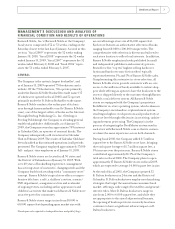Barnes and Noble 2008 Annual Report Download - page 17
Download and view the complete annual report
Please find page 17 of the 2008 Barnes and Noble annual report below. You can navigate through the pages in the report by either clicking on the pages listed below, or by using the keyword search tool below to find specific information within the annual report.
Stock-Based Compensation
The calculation of share-based employee compensation
expense involves estimates that require management’s
judgment. These estimates include the fair value of each
of the stock option awards granted, which is estimated
on the date of grant using a Black-Scholes option pric-
ing model. There are two signifi cant inputs into the
Black-Scholes option pricing model: expected volatility
and expected term. The Company estimates expected
volatility based on traded option volatility of the
Company’s stock over a term equal to the expected term
of the option granted. The expected term of stock option
awards granted is derived from historical exercise
experience under the Company’s stock option plans and
represents the period of time that stock option awards
granted are expected to be outstanding. The assump-
tions used in calculating the fair value of share-based
payment awards represent management’s best estimates,
but these estimates involve inherent uncertainties
and the application of management’s judgment. As a
result, if factors change and the Company uses diff erent
assumptions, stock-based compensation expense could
be materially diff erent in the future. In addition, the
Company is required to estimate the expected forfei-
ture rate, and only recognize expense for those shares
expected to vest. If the Company’s actual forfeiture rate
is materially diff erent from its estimate, the stock-
based compensation expense could be signifi cantly
diff erent from what the Company has recorded in the
current period. See Note 3 to the Consolidated Financial
Statements for a further discussion on stock-based
compensation.
Other Long-Lived Assets
The Company’s other long-lived assets include property
and equipment and amortizable intangibles. At January
31, 2009, the Company had $820.7 million of property
and equipment, net of accumulated depreciation, and
$13.6 million of amortizable intangible assets, net of
accumulated amortization, accounting for approximately
27.9% of the Company’s total assets. The Company
reviews its long-lived assets for impairment whenever
events or changes in circumstances indicate that the
carrying amount of an asset may not be recoverable in
accordance with Statement of Financial Accounting
Standards (SFAS) No. 144, Accounting for the Impairment
or Disposal of Long-Lived Assets. The Company evaluates
long-lived assets for impairment at the individual store
level, which is the lowest level at which individual cash
fl ows can be identifi ed. When evaluating long-lived
assets for potential impairment, the Company will
fi rst compare the carrying amount of the assets to the
individual store’s estimated future undiscounted cash
fl ows. If the estimated future cash fl ows are less than
the carrying amount of the assets, an impairment loss
calculation is prepared. The impairment loss calcula-
tion compares the carrying amount of the assets to the
individual store’s fair value based on its estimated dis-
counted future cash fl ows. If required, an impairment
loss is recorded for that portion of the asset’s carrying
value in excess of fair value. Impairment losses included
in selling and administrative expenses totaled $11.7 mil-
lion, $5.9 million and $3.4 million in fi scal 2008, 2007
and 2006, respectively, and are related to individual
store locations.
Goodwill and Unamortizable Intangible Assets
At January 31, 2009, the Company had $240.0 million of
goodwill and $69.9 million of unamortizable intangible
assets (those with an indefi nite useful life), accounting
for approximately 10.4% of the Company’s total assets.
SFAS No. 142, Goodwill and Other Intangible Assets (SFAS
142), requires that goodwill and other unamortizable
intangible assets no longer be amortized, but instead be
tested for impairment at least annually or earlier if there
are impairment indicators. The Company performs a
two-step process for impairment testing of goodwill as
required by SFAS 142. The fi rst step of this test, used to
identify potential impairment, compares the estimated
fair value of a reporting unit with its carrying amount.
The second step (if necessary) measures the amount of
the impairment. The Company completed its annual
impairment test on the goodwill in November 2008
and deemed that no impairment charge was necessary.
The Company has noted no subsequent indicators of
impairment. During the third quarter of fi scal 2007, the
Company reevaluated the categorization of distribu-
tion contracts based on the then recently observed rate
of contract retention and reclassifi ed certain of these
contracts having a recorded value of $8.3 million from
an unamortizable intangible asset to an amortizable
intangible asset. Such distribution contracts were
tested for impairment prior to the reclassifi cation and
the Company determined that no impairment charge
was necessary. The Company also completed its annual
impairment tests for its other unamortizable intangible
16 Barnes & Noble, Inc. MANAGEMENT’S DISCUSSION AND ANALYSIS OF FINANCIAL CONDITION AND RESULTS OF OPERATIONS continued
























